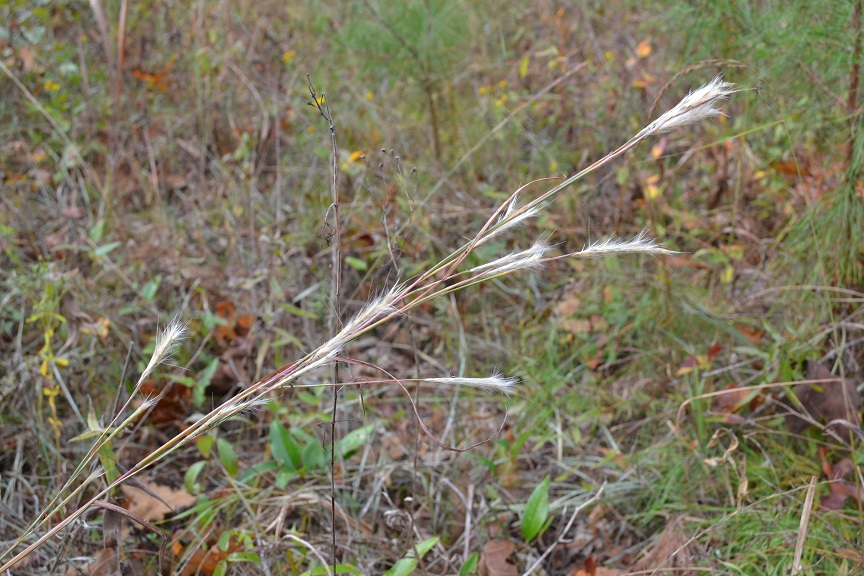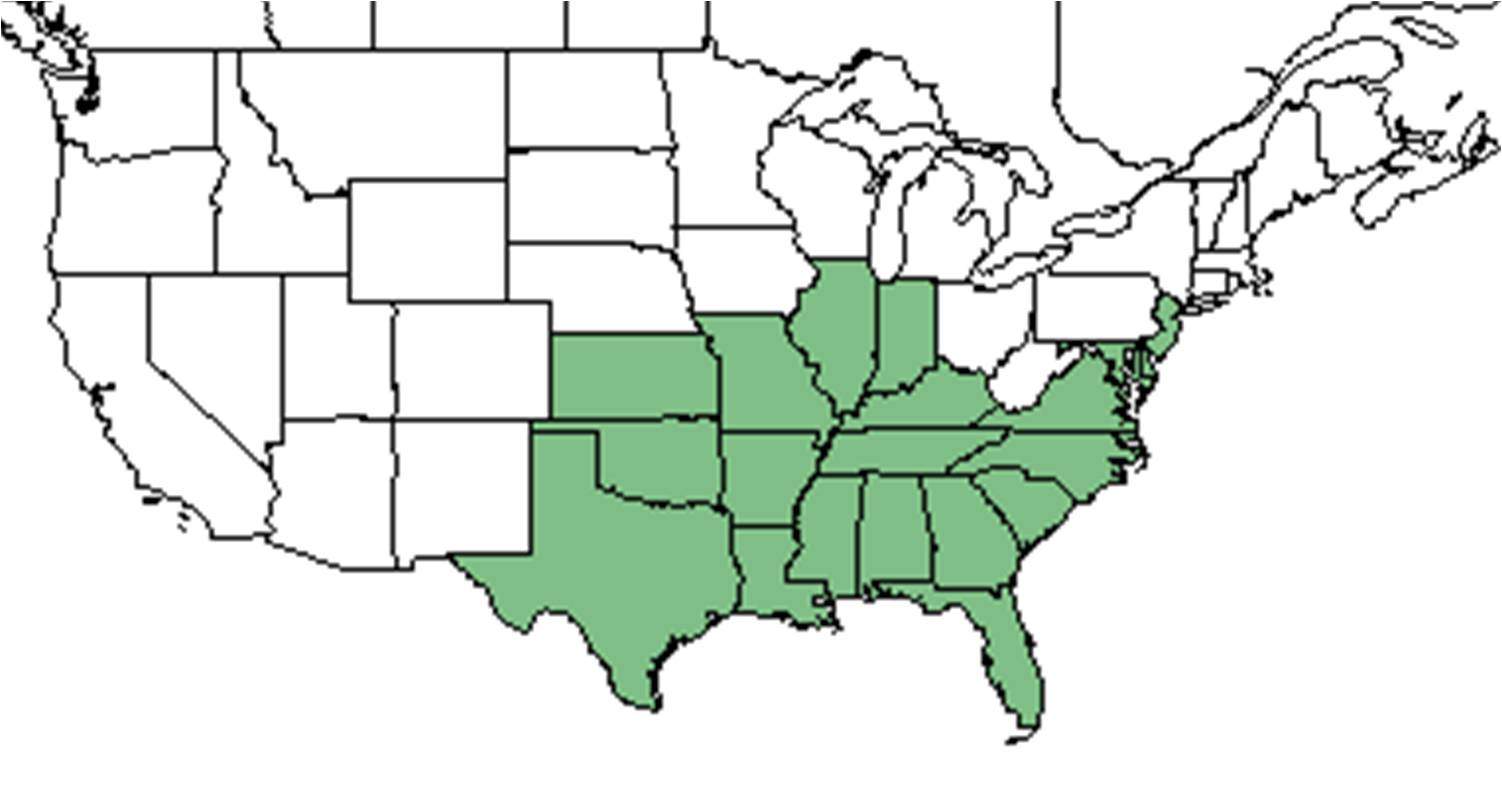Andropogon ternarius
| Andropogon ternarius | |
|---|---|

| |
| Andropogon ternarius taken by Kevin Robertson | |
| Scientific classification | |
| Kingdom: | Plantae |
| Division: | Magnoliophyta - Flowering plants |
| Class: | Moncots or Dicots |
| Order: | Cyperales |
| Family: | Poaceae/Gramineae |
| Genus: | Genus |
| Species: | A. ternarius |
| Binomial name | |
| Andropogon ternarius Michx. | |

| |
| Natural range of Andropogon ternarius from USDA NRCS Plants Database. | |
Common name: Splitbeard bluestem
Contents
Taxonomic notes
Synonyms: Andropogon ternarius var. ternarius; A. ternarius; A. ternarius var. ternarius; A. ternarius var. glaucescens (Scribner) Fernald & Griscom
Description
Annual, tufted grass, 5 ft tall. NinaRaymond
Cespitose or tufted perennial that comes from hardened bases or short rhizomes. The culms are usually glaucous and sometimes purple in color. The nodes and internodes are usually glabrous. The leaves are basal and cauline. The blades are scaberulous, frequently hirsute or pilose on the upper surface above the ligule. The sheaths are keeled, the margins are scarious, the ligules are membranous, erose or ciliolate, and 0.5-1.5mm long. The collars are glabrous or hirsute. There are numerous racemes that are pedunculated, exserted or inserted in subtending sheaths. The spikelets are in pairs, sessile fertile, pedicellate either staminate, reduced or absent. The glumes are usually scaberulous, subequal, acute to aristate, the first are keeled and somewhat scarious, the second is usually sulcate and somewhat cartilaginous. There are fertile and sterile lemmas hyaline that are subequal that are shorter than glumes. The fertile lemma are awned. The paleas are hyaline and are reduced. The callus beard is usually longer than the spikelet. The grain is purplish or yellowish in color, is linear-ellipsoid in shape, and 2-3mm long.[1]
The culms are 0.7-1.5m tall. The blades are 3dm long and 2-3.5mm wide. There are 2-3 racemes that are villously white and are 1.5-4cm long. The rachis joins and pedicels are densely villous and are 3-10mm long. The peduncles are exserted and are 4-15cm long; sheaths are tight. The fertile spikelet are 5-5mm long, exceeding rachis joint. The lemma awn is slightly twisted and is 1.5-2.5cm long. The sterile spikelet and pedicel are equal and a little longer than the fertile spikelet, the pedicel is flat. Flowers from September to October.[1]
Distribution
Ecology
Habitat
In the Coastal Plain in Florida and Georgia, Andropogon ternarius has been found in pine/oak sandhills, pine scrubs, turkey oak scrubs, upland pine forests, river banks, and pine flatwoods. It can occur in disturbed areas such as roadsides, recreation areas, cut-over pinewoods, gas line corridors, slash pine plantations, old fields and cultivated fields.[2] Associated species include Pteridium, Crataegus lacrimata, Psoralea lupinellus, Aristida purpurascens, Sorghastrum elliottii, Eragrostis hirsuta, Dichanthelium, and Muhlenbergia expansa.[2] Soil types include sand, loamy sand, loam, sandy alluvium, and sandy loam.[2]
Phenology
Andropogon ternarius has been observed to flower and fruit May through December.[2][3]
Fire ecology
A. ternarius has been recorded in annually burned upland pines and pine savannas.[2]
Conservation and management
Cultivation and restoration
Photo Gallery
References and notes
- ↑ 1.0 1.1 Radford, Albert E., Harry E. Ahles, and C. Ritchie Bell. Manual of the Vascular Flora of the Carolinas. 1964, 1968. The University of North Carolina Press. 162-163. Print.
- ↑ 2.0 2.1 2.2 2.3 2.4 Florida State University Robert K. Godfrey Herbarium database. URL: http://herbarium.bio.fsu.edu. Last accessed: October 2015. Collectors: Jame Amoroso, Loran Anderson, Wilson Baker, Kathleen Craddock Burks, A.F. Clewell, A.H. Curtiss, R. K. Godfrey, D. C. Hunt, R. Komarek, R. Kral, Karen MacClendon, Travis MacClendon, Sidney McDaniel, Marc Minno, Richard S. Mitchell, J. Roche, Cecil R. Slaughter, George Wilder, Jean W. Wooten, Bian Tan. States and Counties: Florida: Baker, Bay, Dixie, Duval, Calhoun, Columbia, Escambia, Franklin, Gadsden, Gilchrist, Jackson, Jefferson, Lake, Leon, Liberty, Madison, Marion, Okaloosa, Taylor, Walton, Wakulla. Georgia: Grady, Thomas. Compiled by Tall Timbers Research Station and Land Conservancy.
- ↑ Nelson, G. PanFlora: Plant data for the eastern United States with emphasis on the Southeastern Coastal Plains, Florida, and the Florida Panhandle. www.gilnelson.com/PanFlora/ Accessed: 7 DEC 2016